 Weird Stuff
Weird Stuff  Weird Stuff
Weird Stuff  Our World
Our World 10 Archaeological Discoveries of 2025 That Refined History
 Weird Stuff
Weird Stuff 10 Fascinating Facts You Might Not Know About Snow
 Miscellaneous
Miscellaneous Top 10 Things Crypto Was Supposed to Change & What Actually Did
 History
History 10 Huge Historical Events That Happened on Christmas Eve
 Music
Music 10 Surprising Origin Stories of Your Favorite Holiday Songs
 History
History 10 Less Than Jolly Events That Occurred on December 25
 Weird Stuff
Weird Stuff 10 Funny Ways That Researchers Overthink Christmas
 Politics
Politics 10 Political Scandals That Sent Crowds Into the Streets
 Weird Stuff
Weird Stuff Ten Bizarre Facts About The Doge Meme
 Weird Stuff
Weird Stuff 10 Weird Things People Used to Do at New Year’s
 Our World
Our World 10 Archaeological Discoveries of 2025 That Refined History
 Weird Stuff
Weird Stuff 10 Fascinating Facts You Might Not Know About Snow
Who's Behind Listverse?

Jamie Frater
Head Editor
Jamie founded Listverse due to an insatiable desire to share fascinating, obscure, and bizarre facts. He has been a guest speaker on numerous national radio and television stations and is a five time published author.
More About Us Miscellaneous
Miscellaneous Top 10 Things Crypto Was Supposed to Change & What Actually Did
 History
History 10 Huge Historical Events That Happened on Christmas Eve
 Music
Music 10 Surprising Origin Stories of Your Favorite Holiday Songs
 History
History 10 Less Than Jolly Events That Occurred on December 25
 Weird Stuff
Weird Stuff 10 Funny Ways That Researchers Overthink Christmas
 Politics
Politics 10 Political Scandals That Sent Crowds Into the Streets
 Weird Stuff
Weird Stuff Ten Bizarre Facts About The Doge Meme
10 Fabulous Graves (Almost) Worth Dying For
Most graves are rather sedate affairs. Memorial stones typically contain the names, dates of birth and death, and brief and respectable epitaphs that tell you nothing about the person buried beneath them.
The meaning behind some memorials may never be known, particularly when those who knew the deceased are dead and gone themselves. For some people, however, their final resting place is a chance to have the last word in an argument or to celebrate their achievements in life.
Whatever the reason for their creation, some gravestones make for very interesting reading.
10 Sir Jeffrey Hudson
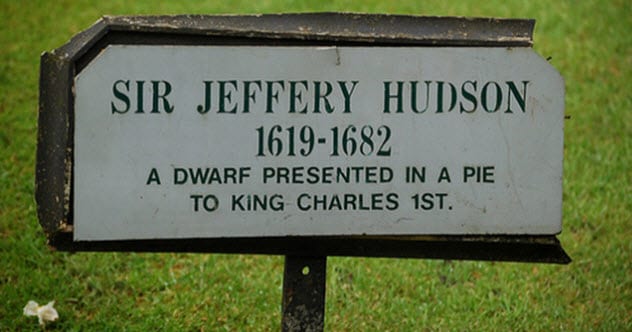
Born in 1619, Sir Jeffrey Hudson had a unique claim to fame when he was alive and his memorial ensures that he will remembered for it in death. Hudson was a dwarf in the court of Queen Henrietta Maria. He was a court jester, an explorer, a soldier, and a slave. He was even captured by pirates.
But his finest hour came when he was hidden inside a pie which was then presented to King Charles I. At some point, Hudson burst out of the pie, presumably to cries of “Surprise!” He was dressed in a miniature set of armor made especially for him. Along with a monkey and a giant, he became a kind of pet of the royal family. The giant and the dwarf developed an act for the entertainment of the royal court.
Hudson was often used to deliver messages for the royal family while they were in the midst of civil war. He was promoted to the position of Captain of Horse, supposedly for being a crack shot and a good rider.
In 1644, Hudson challenged a man to a duel and shot his opponent dead, which was unfortunate as his enemy had armed himself only with a water pistol. Hudson was sentenced to death. But after the queen’s intervention, he was exiled instead.
Soon after, he was captured by Barbary pirates and sold into slavery in Africa. Hudson spent 25 years as a slave, during which time he grew 56 centimeters (22 in). He claimed that his growth spurt was caused by the constant “buggery” he was subjected to. Eventually, he was rescued, only to be brought home and thrown into prison for being Catholic. He spent the next 14 years there.[1]
Though Hudson’s life was full of adventure, his memorial contains only the line, “A Dwarf presented in a pie to King Charles 1st.” However, if you wanted something that summed up the strange nature of Jeffrey Hudson’s life, that line is probably as good as any.
9 Jules Verne

The author Jules Verne is considered to be one of the founders of modern science fiction writing. The author of Around the World in 80 Days and 20,000 Leagues Under the Sea wanted to create a new genre that combined fiction with scientific fact—or as he called it, “scientifiction.”[2]
So it was natural that Verne would want a memorial at his death that was both remarkable and challenged the imagination. The grave seems perfectly conventional at first. It has a headstone giving details of his birth and death.
At the base of the gravestone, however, a statue of a naked man emerges from the ground. Presumably, it represents Jules Verne or possibly Christ pushing back the tombstone and climbing out of the grave with his hand stretched toward the heavens. The piece was designed by Albert-Dominique Roze and is entitled Towards Immortality and Eternal Youth.
The statue is certainly memorable and challenges the imagination, though the purpose is not clear. It is also likely to scare the living daylights out of families visiting the cemetery at dusk.
8 Charles Pigeon

Charles Pigeon seems to have been proud of two things—his family and his invention. Pigeon had invented a gas lamp which did not explode. That would have been handy in 1884.
The lamp won a silver medal at the 1855 Paris Exposition. He sold the lamps in a variety of styles in his own store in Paris and patented the design. He must have made a good living from the lamps because he was able to have a remarkable memorial built on a plot large enough to hold 18 members of his family.
The gravestone takes the shape of a double bed and contains effigies of his wife in evening dress and Pigeon in a business suit. He is reading from a book while his wife listens to him. As if that weren’t grand enough, an angel hovers over them while holding a Pigeon lamp.[3]
7 Jerry Bibb Balisok

The memorial to Jerry Bibb Balisok is as strange as it is misleading. The plaque declares that Balisok was murdered in Guyana in 1978 and includes the epitaph “Damn The State Dept.”
Balisok’s mother had erected the memorial after seeing what she believed to be the body of her son on TV after the Jonestown Massacre in Guyana, in which more than 900 religious followers of Jim Jones were killed in a mass suicide/murder in their compound-cum-temple. It is unclear why she thought Balisok was there.
Balisok, a one-time professional wrestler known as Mr. X, fled the US with his girlfriend after being charged with check fraud. The bodies recovered after the Jonestown Massacre were so badly burned that they were unidentifiable. But Mrs. Balisok was convinced that her son was dead and erected the memorial stone over an empty grave.
Balisok’s mother died in 1983, maintaining to the end of her life that her son had been killed in the massacre. Perhaps it was just as well that she died when she did. In 1989, Balisok resurfaced after being charged with the attempted murder of his business partner. It turned out that Balisok had assumed a stolen identity when he first absconded and had left a trail of criminal carnage behind him ever since.[4]
6 Jonathan And Mary Reed

They say true love is hard to find. So when you do find someone you are happy with, why let a little thing like death come between you? When Jonathan Reed’s wife, Mary, died in 1893, he laid her to rest in a mausoleum in Brooklyn and placed an empty coffin next to it for himself.
Reed decorated the tomb “like a living room in a fine house,” with a stove, paintings on the wall, a clock, and pictures of Mary. He even included his wife’s half-finished knitting and their pet parrot. When the parrot died, he had it stuffed and returned it to its perch.
Jonathan Reed visited his wife in the mausoleum every day until his death over 10 years later. He would arrive just as the cemetery opened and only left when they were locking the gates each night.
Soon he was joined by friends and then visitors from around the world, including seven Buddhist monks who traveled from Burma specifically to visit the mausoleum. Several ladies made it their mission to try to cure Jonathan Reed of his grief, although they were not successful.
In 1905, Jonathan Reed was found dead on the floor of the mausoleum. It is said that his arm was outstretched toward his wife. He was finally laid to rest beside her.[5]
5 Giles Corey
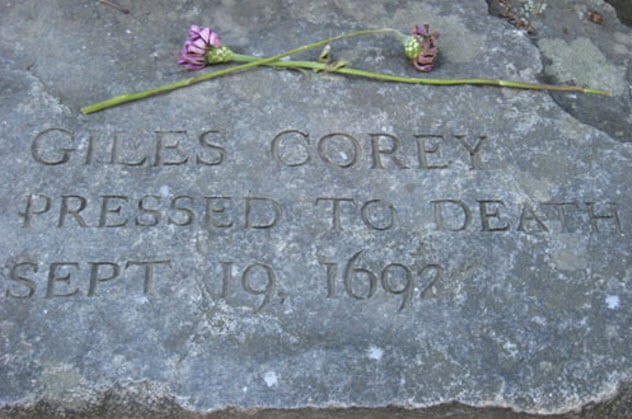
Giles Corey was a farmer in Salem when he was accused of witchcraft in 1692. An unpopular man, he had a reputation for violence, having once been charged with beating his farmhand to death. Corey’s wife was initially charged with witchcraft, and Giles Corey even testified against her.
Then a number of villagers accused Corey of using witchcraft against them. When his accusers appeared to suffer fits in the courtroom, Corey’s hands were bound to prevent him from casting spells on them. After his arrest, he refused to testify further against his wife.
Giles Corey refused to enter a plea at the trial, and he was tortured in an attempt to make him speak. He was stripped naked and laid on the ground. Then a board was placed on top of him. Heavy stones were positioned on the board to crush him. More stones were added over several days of torture to try to compel him to speak.
Despite the torture, Corey supposedly refused to speak, except to urge his tormentors to add “more weight.” His body was ordered to be buried in an unmarked grave on Gallows Hill.
Two days after Giles Corey’s death, his wife was hanged in the same place. A simple gravestone was added at a later date with his name, the date of his death, and the legend “Pressed to Death.”[6]
4 Robert Clay Allison
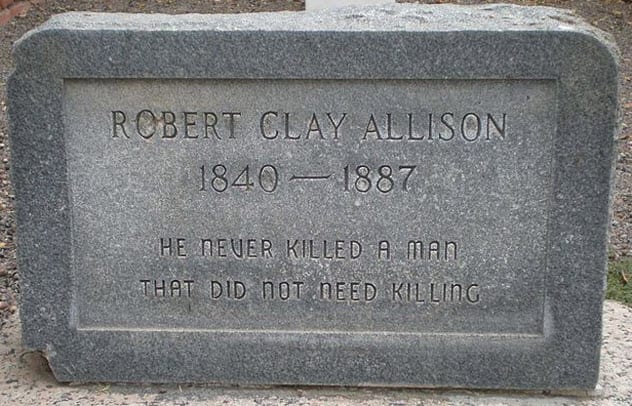
Robert Clay Allison was a gunslinger of the Old West. Having fought for the Confederacy, he became a cattle herder. In 1870, he killed Charles Kennedy by breaking into the jail where Kennedy was held, putting a rope around his neck, and dragging him behind his horse up and down the main street until he was decapitated. It wasn’t Allison’s first killing. Or, sadly, his last.
Allison was not killed in a gunfight. Instead, a freak accident took his life when a sack of grain fell from a moving wagon. As Allison reached for it, he fell and the wagon wheel ran over his head.
He is buried in Reeves County, Texas. Allison was said to have disliked his reputation as a shootist and did everything he could to live it down. Perhaps, then, he would not have been too happy with his headstone. It reads: “He never killed a man that did not need killing.”[7]
3 Lilly E. Gray

The grave of Lilly E. Gray is perhaps the most interesting thing about her. Born in 1880, she seems to have led a fairly humdrum life until she married Elmer Gray, who had served multiple prison sentences for burglary. Elmer Gray seems to have been something of a conspiracy theorist. During one of his parole hearings, he alleged that he had been “kidnapped by five democrat officials.”
Elmer and Lilly married when she was 72 and he was just a year younger. She died of natural causes six years later.
Her life would have been entirely unremarkable, except to her family, had it not been for the headstone which Elmer Gray erected over his wife’s grave. It read: “Lilly Edith Gray, Victim of the Beast 666.”[8]
There is no clue on the grave as to the meaning, but its ominous words have spawned dozens of theories. Most of them, shall we say, are incapable of proof. It is known that Elmer Gray in his last years had some mental health issues, so the most likely explanation is that he ordered his wife’s stone while delusional.
Still. It makes for a good story.
2 Rosalia Lombardo
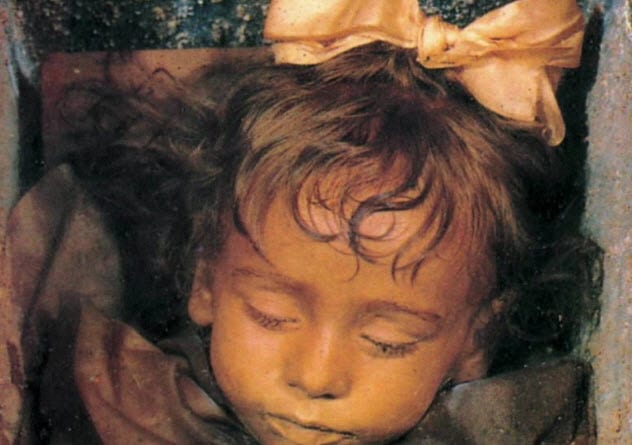
Rosalia Lombardo was born in 1918 in Sicily and died just two years later. Devastated by grief, her father approached the famous embalmer Dr. Alfredo Salafia and asked him to preserve her body. Hers was one of the very last corpses to be placed in the Capuchin Catacombs of Palermo.
Dr. Salafia did such a good job that Rosalia looked as though she were sleeping. Her body was placed in a glass tomb in a small chapel at the end of the catacombs. She is so lifelike that many locals believed that she was a doll. Although the body has begun to decay in recent years, Dr. Salafia’s skill was highly regarded and his embalming technique is a closely guarded secret.[9]
Quite why Rosalia’s father wanted to preserve his daughter forever is not known. But thanks to the skills of Dr. Salafia and the Capuchin monks who guarded the tomb, Sleeping Beauty, as she came to be called, sleeps on.
1 Timothy Clark Smith
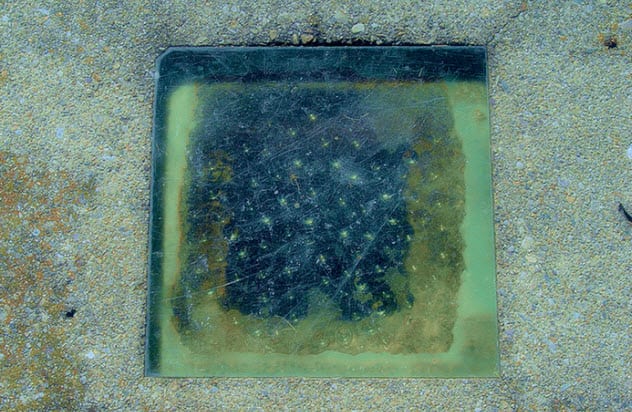
Timothy Clark Smith must have been a careful man. The sort of person who looks twice before crossing the road. During the 17th century, it is true that a large number of cases of apparently dead people narrowly escaped being buried alive. There is no way to tell how many more failed to wake up in time.
Smith was a teacher, merchant, clerk, and finally a doctor. He took a position as a staff surgeon in the Russian army and probably saw a number of disturbing near misses as part of his job. He was said to be mortally afraid of contracting sleeping sickness and waking in his grave.
So when he died in 1893, it was perhaps inevitable that he would take steps to make sure that he could attract attention if he needed to. He installed a viewing window in his coffin and ensured that the window was positioned at the bottom of a cement tube that led to the surface. It is also believed that he was buried with a hammer and chisel and held a bell in his hand to attract the attention of rescuers.[10]
Smith’s grave can still be seen in the cemetery in Vermont, and the viewing window is still there. Unfortunately—or fortunately, depending on your point of view—Smith did not take into account the effect of condensation on the glass. It is now almost impossible to see anything in the grave below.
Ward Hazell is a writer who travels and an occasional travel writer.
Read more fascinating stories about mysterious graves on 10 Mysterious Graves That Defy Explanation and Top 10 Rare Finds From Mass Graves And Battlefields.








